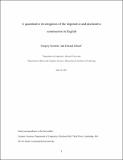A quantitative investigation of the imperative-and-declarative construction in English
Author(s)
Scontras, Gregory; Gibson, Edward A.
DownloadScontras&Gibson-IaD paper[1].pdf (249.1Kb)
OPEN_ACCESS_POLICY
Open Access Policy
Creative Commons Attribution-Noncommercial-Share Alike
Terms of use
Metadata
Show full item recordAbstract
The imperative-and-declarative (IaD) construction in English (e.g. Study hard and you will pass the class) has two distinct readings: one that has the semantics of a conditional and additionally the meaning of an imperative, and one that has only the semantics of a conditional, with no imperative meaning. There are two general kinds of syntactic approaches in the literature for analyzing this construction: one that treats the two interpretations as underlyingly syntactically the same, and one that treats them as two distinct syntactic constructions. This short report presents the results of an acceptability-judgment experiment that was designed to inform the debate between the two kinds of approaches. The two types of IaDs were observed to behave differently with respect to two phenomena we evaluated, suggesting either that they should be treated as grammatically distinct, or that a theory that treats them as grammatically the same must give a pragmatic account of the differences. Furthermore, because the pattern of data that we observed was a statistical interaction between two factors—a pattern of data that is not detectable without quantitative measurements—the results provide compelling evidence for the need for quantitative evaluations of linguistic hypotheses.
Date issued
2011-12Department
Massachusetts Institute of Technology. Department of Brain and Cognitive SciencesJournal
Language
Publisher
John Hopkins University Press
Citation
Scontras, Gregory, and Edward Gibson. “A Quantitative Investigation of the Imperative-and-declarative Construction in English.” Language 87.4 (2011): 817–829. Web.
Version: Author's final manuscript
ISSN
0097-8507
1535-0665